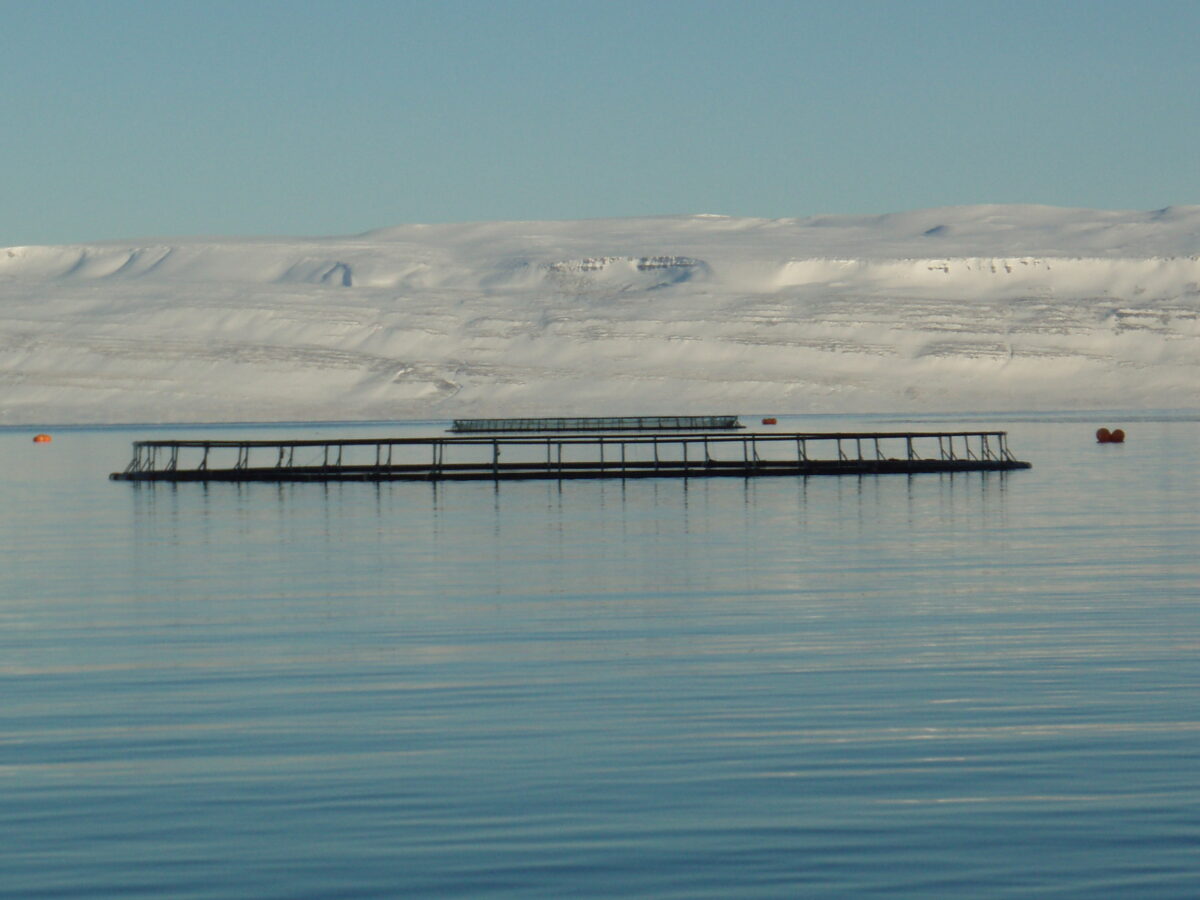The Nordic countries are major players in fish farming, including salmon (Salmo salar). Many demanding environmental issues are related to this production and they are found in every step of the process. The main focus of this report has been on new feed ingredients and improved utilization of by-products. Both of these issues concern a large amount and it is of great importance for the business world as well as the sustainability and environmental impact of this important profession that they are handled in a better and more efficient way than the current methods. Future food security for our planet's population, in a sustainable manner in the long term, requires a revolution in the way we produce our food. There is an urgent need to maximize sustainable feed production.
_____
The Nordic countries are big players in salmon aquaculture (Salmo salar). Many challenging environmental issues are related to this production, and they are to be found in every step of the process. The main focus in this report has been put on novel and alternative feed ingredients and sidestreams utilization. Both those issues involve vast volumes and it's of high importance for the economy as well as the sustainability and environmental impact of this important profession that they are tackled in a better and more efficient manner than current approaches. Future food security for our global population that does not compromise the long-term sustainability of our ecosystems requires a revolution in the way we produce our food and there is an urgent need to nutritionally optimize a sustainably produced feed ingredient for inclusion in aquafeeds.
Tag: Aquaculture

Side streams in aquaculture are mostly divided into two categories, ie. K2, which is a fish that dies by itself in pens, and K3, which is offal that occurs during slaughter, as well as heads, spines and trimmings that occur during processing. Raw materials from K2 may not be processed for human consumption or in feed for animals bred for human consumption, and therefore other markets must be considered, for example pet or fur animals. However, K3 can go into production for human consumption or in the feed of animals consumed by humans.
This is a significant amount that is added as a by-product of aquaculture in Iceland. More than five thousand tons of K2 and more than two thousand tons in K3 are expected. Today, these raw materials are mostly processed into malt, which is exported to Norway for further processing into animal feed. Processing of by-products from fillet processing has been frozen and used to make feed for fur farming.
Spontaneously dead fish from pens (K2) are immediately processed on board feed barges and delivered to local Norwegian buyers on board cargo ships. Due to the limited use of this raw material, the values are below the cost price of smelt production. There are more possibilities for the production of digestate from K3, which can be used to make feed for farm animals and even for human consumption, which increases the value considerably. It has been agreed with buyers that if they take K2, they will also get K3, without payment for products of both categories.
In this project "Value creation in Icelandic aquaculture", which was partially financed by the AVS research fund in the fishing industry/Food Fund, points out ways to increase value creation in digestate processing. The project looked for ways to reduce costs and increase value in the production of digestate from the by-streams of aquaculture, where in particular the aim was to reduce transport costs by processing the digestate more, removing fish oil and water from it, which reduces volume and weight during transport and gives the opportunity to work it into more expensive products. Salmon farming in Iceland today is spread across East Iceland and Vestfjörður, in addition to extensive land farming being prepared in at least three locations in the South, and therefore it is important to find solutions to collect and transport the side raw materials from fire and slaughter to further processing, but considerable equipment needed for that.
The project explores important possibilities in the utilization of K2 and K3, which until now has been a cost for the fish farm and could turn it into value creation. To advance these ideas, it is necessary for the research community to work closely with aquaculture companies and regulatory authorities.
- The thickening is carried out by steaming under vacuum which takes place at 30-50°C and therefore the properties of the proteins are mostly preserved. But during drying, some of these properties are degraded due to the high evaporation temperature during drying.
- In the future, it would be possible to think of using concentrate directly in feed production and omitting the drying step, which is costly (capital costs are high and also operating costs) and not environmentally friendly. In this way, it would be possible to significantly reduce soot during this processing and the feed would be more environmentally friendly.
To move forward, it is important to develop these ideas in collaboration with the industry and the research community. It is also important that the government and regulatory bodies get involved in order to ensure that the regulatory framework is in line with the needs and requirements of all stakeholders.
Aquaculture is growing rapidly around the world and is playing an increasingly important role in ensuring food security. Iceland is the largest producer of char in the world, but char has a great need for protein, which has mostly been met by feed that is rich in fishmeal. Fishmeal, on the other hand, is an expensive source of protein, so feed costs in charr farming are around 50% of production costs, in addition to which fishmeal is a limited resource. It is therefore important to look for new protein sources for char producers. One such option is to use soybean meal, which has been used successfully in salmon farming. However, there are studies that suggest that soybean meal may have a negative effect on the growth, intestinal flora and general well-being of salmonids.
This report discusses the main results of the AVS project "Development of new charr feed", the aim of which was to reduce feed costs and increase sustainability in charr farming by replacing fishmeal with soybean meal in feed. The project also sought to gain an understanding of the effects of different "treatment" soybean meal on the growth, intestinal flora and welfare of char.
Four different types of feed were studied, ie. conventional feed with fishmeal (FM), with untreated soybean meal (US), with enzyme-treated soybean meal (ES), and with untreated soybean meal with added beneficial bacteria (USP). The survival, growth, behavior and intestinal flora of the char fed for 10 weeks on the aforementioned four types of feed were then compared. The char that was tested was a small fish at the stage where there is a lot of growth and the intestinal flora is being shaped; and therefore the effect of the feed is particularly important.
The main results of the project were that feed containing Hypro soybean meal with added FOS beneficial bacteria significantly reduced growth, compared to the other types of feed. The enzyme-treated soybean meal, which contained degraded NSPs that act as beneficial bacteria, as well as the untreated soybean meal with added beneficial bacteria, contributed to a more diverse intestinal flora and increased levels of lactic acid bacteria (LABs) that have been linked to disease and immune resistance, . The results also showed that the fish's behavior towards the untreated soybean meal was significantly different from that of the other feeds, in that they showed less interest in the feed.
The results indicate that the addition of beneficial bacteria at this stage of growth promotes positive changes in the intestinal flora, and can therefore lead to increased tolerance to stress and disease later in life. However, this seems to be detrimental to fish growth. Further research is therefore needed to determine whether the growth will pay off in the later stages of charr growth and whether survival and other positive traits will increase. FOS benign bacteria may not be suitable for fish at such an early stage of development, but it seems that FOS affects metabolism and intestinal needs and the immune system. But further research is needed to draw further conclusions. The enzyme-treated soybean meal did not have the same negative effect on growth, but the variability was greater. LABs in the intestinal flora indicate that the treatment promotes endangered health and resistance to infections, without affecting growth. The results suggest that enzyme treatment of soybean meal in feed contributes to improved health and survival of char. It is important that future research examines the results of this project and compares it with the condition of intestinal tissues. It is also important to further investigate how metabolism, behavior and intestinal flora interact with different feeding in previous life stages, as well as what the effects are on long-term growth and well-being.
Skýrslan er lokuð / This report is closed
Aquaculture is globally growing in importance as part of the solution for future food security. In Iceland one of the most important farmed species is the salmonid, Arctic Charr, and Iceland is the world's leading producers of this cold-water, carnivorous species. Arctic Charr has a high dietary protein requirement which is traditionally provided by diets high in fish meal protein. This drives feed costs that are 50% of the total production costs and puts pressure on wild capture fisheries from which fish meal species are sourced. To facilitate the further expansion of Arctic charr aquaculture it is necessary to find less expensive and more environmentally sustainable feed ingredients. One potential alternative that is widely used in Atlantic Salmon aquaculture is soybean meal, however increasing evidence suggests that for some salmonids, untreated soybean meal can have negative consequences for growth, good health and welfare.
The overall aim of this study was to decrease Arctic Charr feed costs and improve the long-term sustainability of salmonid aquaculture in Iceland by replacing fish meal with untreated and treated soybean meal. This study also aimed to understand the wider consequences of untreated and treated soybean meal on the growth, gut health and welfare of Arctic Charr.
Four different diets were assessed, a fish meal control (FM), an untreated soybean meal (US), an enzyme pre-treated soybean meal (ES) and an untreated soybean meal with an added prebiotic (USP). The survival, growth performance, gut microbiome assembly, and behavior were of juvenile Arctic Charr fed each of these diets during a 10-week feeding trial were compared. The juvenile life stage was selected since it is a period of crucial developmental, when growth rates a very rapid, and the gut microbiome is colonizing, so impact of differing diets can be obtained quickly.
The key findings of this report were that the addition of FOS prebiotic to untreated Hypro soybean meal feed treatment significantly reduced growth compared to the fish meal control when all other feed treatments including the enzyme treated soybean meal performed significantly the same as the fish meal control. The enzyme treatment of soybean meal which aimed to have a secondary benefit of the broken down NSPs acting as prebiotics, as well as the untreated soybean meal with prebiotic had higher gut microbiome diversity as well as a greater presence of Lactic Acid Bacteria (LABs) which are both associated with positive benefits such as more immune robustness and resilience to disease and infection as well as benefits for nutritional uptake and growth. There was also a notable difference in behavior where the fish fed the untreated soybean meal with added prebiotic were both shyer and less active than the fish fed any other feed treatment, indicating that they were more reactive individuals.
When the results of these different tests are viewed together this suggests that the addition of pure prebiotics at such an early developmental stage does promote beneficial changes to the gut microbiome which suggests that the fish will be more resilient to stress and disease later in life and may receive other benefits of prebiotic addition too, however at this early stage the combination with low growth performance suggests that the immune system and gut development may be stimulated but at the cost of energy being drawn away from growth. Salmonids given FOS should be followed from early development through to harvest to see if growth can be compensated and if survival or performance is in fact improved. Otherwise these results may indicate that FOS may not be suitable to apply to diets during such early stages of development, when growth curves are steep naturally. The observation that these fish were also had more reactive coping strategies suggests that the prebiotic application may also effect metabolic rate which could be linked to the stimulation of the gut and immune system, but further experimentation will be needed to elucidate this and also to investigate the consequence of this altered behavior, which could potentially reduce the welfare of an intensively farmed fish. On the other hand, the enzymatic treatment of soybean meal did not show the same negative impact to early growth performance but did influence a higher diversity and LABs presence in the gut microbiome suggesting this method of threatening soybean meal may bring benefits to health and resilience without as much trade-off. These enzyme-soy treated fish groups were also slightly more reactive than the control treatments, but the impact was not as pre-announced as for the prebiotic added treatment. Overall the results suggest that the best potential benefit to long term health and survival of charr when soybean meal is pre-treated with enzymes when used in the diet.
It will be extremely important in the future to combine these results with gut histology data to clarify the impact of differing treatments to internal gut morphology and health. It will also be important to further study how metabolism, behavior and the gut microbiome interact with dietary treatments at this early development stage and what the long-term consequences for production and welfare will be.
Drug residues in the Icelandic environment
The aim of the audit was to assess the theoretical release of drugs into the environment (receptors) in Iceland, with an emphasis on coastal waters, rivers and lakes. For medicinal products used for humans, an assessment was made of the concentration of these medicinal products in the sewerage system in the capital area and in two selected locations outside the capital area. For medicinal products used in agriculture and aquaculture, a theoretical assessment was made of the release of medicinal products from production units where the emissions could be the highest. The potential concentration of the drugs in the receptors was assessed and these values were compared with the expected risk, as there are environmental limits. The drugs that were examined and evaluated were determined on the basis of Icelandic sales figures and the priority list of the European Union's Water Framework Directive, together with the results of previous research. The following human medicinal products were examined: estradiol, ethinyl estradiol, amoxicillin, azithromycin, fluconazole, paracetamol, ibuprofen, diclofenac, metoprolol, fluoxetine, sertraline and the veterinary medicinal products emamectin benzoate (laxalucalicylphenyl). Theoretical evaluation suggests that the levels of ibuprofen, amoxicillin, fluoxetine, paracetamol, diclofenac, azithromycin and sertraline need to be further investigated in sewage treatment plant receptors. The results for the veterinary medicinal product do not indicate a risk of procaine benzylpenicillin used in pig farming or emamectin benzoate used in aquaculture.
View report
Method development to estimate infection load in aquaculture
The aim of the pilot project was to create a DNA probe that binds to the genetic material of the fish-causing bacteria Flavobacterium psychrophilum and Aeromonas salmonicida, a subspecies of achromogenes, which can be detected using microscopy (FISH) and flow cytometry. One selective DNA probe for the bacterium F. psychrophilum was created with a combination of two and used with great success to screen for the bacterium using microbial and FISH technology. Specific DNA sensors could not be generated for A. Salmonicida, a subspecies of achromogenes, as its identification gene (16S rDNA) is too similar to other non-infectious Aeromans species. It will be necessary to develop new tentacles that are unique to A. Salmonicida, a subspecies of achromogenes. The flow cytometry is a very fast tool for detecting the binding of specific DNA sensors to microorganisms, which makes the device very suitable for detecting pathogenic bacteria in water. Quantitative analysis of bacteria with such technology is subject to various shortcomings, but it still gives a very good indication of the condition of the water in the fire so that the infection burden can be assessed. The results of this preliminary project show that it is possible to assess the infection burden in aquaculture quickly, but it is necessary to further develop and verify the methodology in real conditions in aquaculture. This was assumed at the beginning of this preliminary project and the participants have applied for a continuation grant to AVS based on the current results and the methodology will be tested under real conditions in charr farming.
The aim of this proof-of-concept study was the development and application of molecular probes for the fish pathogens Flavobacterium psychrophilum and Aeromonas salmonicida subsp. achromogenes, and their detection through Fluorescence In Situ Hybridization (FISH) and flow cytometry. A combination of two species-specific FISH probes was successfully used in combination with flow cytometry to identify and detected F. psychrophilum strains. It was not possible to find specific FISH probes for A. salmonicida subsp. achromogenes. The bacterium is too similar to other Aeromonas species in its 16S rRNA gene sequence and does not contain suitably unique regions that could have been used to develop a species-specific FISH probe. Flow cytometry offers a fast detection system for FISH probes, although technological limitations make reliable quantification difficult. The system is therefore best suited as a semi-quantitative early warning system for emerging fish pathogens in water samples from aquaculture tanks. The results of this preliminary project show that it is possible to estimate the infection load for certain pathogens in aquaculture rapidly but it is necessary to develop the methodology further and test it under real aquaculture conditions. The participants have applied to AVS for new funding based on these results; to develop our rapid methodology further, expand it to more pathogens and test it under real aquaculture conditions.
View report
Testing different types of impregnations and its effect on bio fouling
The use of copper oxide in the treatment paint of cow bags is highly criticized and has been banned in many places due to its negative effects on the environment. Within the European Union, the use has been grayed out due to these negative effects of the substance on the environment, but it has been difficult to ban it as no substances have been found that repel sediments as well from the sacs as copper oxide. In the Norðurkví project, there has been a project where an attempt has been made to find a substance that could replace the copper oxide, but no permanent solution has been found. The results of this experiment are presented in this report.
Usage of copper oxide in treating net ‐ bags in aquaculture is a controversial and has been banned in many countries due to its negative environmental impact. Within the EU, use of copper oxide has been put on a gray list but not banned because no substitute treating material has been found which has the same effect in keeping algae away from the nets ‐ bags. The North Cage project has been looking into finding alternative solutions to copper oxide, and the conclusion of this research is drafted in this report.
View report
Utilization of raw materials from the plant and animal kingdom in fish feed
Feed costs in aquaculture are generally around 50‐70% of operating costs and a large proportion of raw materials in feed are imported. The purpose of this report is to compile information on the possibility of utilizing domestic raw materials used in agriculture and fisheries for aquaculture feed. It is considered that the raw materials are generally used for aquaculture and the summary is not limited to individual species. It is possible to use by-products from the fisheries sector as feed in aquaculture, but by-products from the plant kingdom need to be treated in order to reduce / eliminate a high proportion of fiber and increase the protein content. By-products of the plant kingdom may be used as food for invertebrates, bacteria and fungi, thus producing a protein-rich product suitable for fish feed.
Feed cost in aquaculture is about 50‐70% of the total cost, and most of the feed is imported. The aim of this report is to gather information about utilizing by-products from agriculture and fishing industry as a feed in aquaculture. By-products from the fishing industry can be used as feed in aquaculture but it is necessary to lower the level of fiber and increase protein in by-products from agriculture. This can possibly be done by using the by-products as feed for invertebrates, bacteria and mushrooms and produce protein rich feed for aquaculture.
View report
Affinity of benthic communities in Ísafjarðardjúpur
Knowledge of benthic life in the shallow waters off Iceland is low, both in terms of natural conditions and under stress from, for example, aquaculture. There is also a lack of knowledge about how benthic communities react to stress from aquaculture, but one study has tried to answer this regarding low stress. In order to understand which benthic community types exist under natural conditions and which are present in the case of pollution from pollution, the relationship between benthic life inside and outside the area must be examined. In this way, it is possible to understand which animal groups are predominant in similar situations. This study uses data on benthic life in Ísafjarðardjúpur, which is mostly due to fish farming in the fjords. A benthic study is also being carried out in fjords that may be suitable for aquaculture, but are still only under pressure from natural conditions. The project is part of a larger project "Icelandic fjords: The natural ecosystem of Ísfjarðardjúp and the limits of pollution" and is funded by the Fisheries Project Fund.
Knowledge about the benthic live in shallow waters around Iceland is poor, both regarding natural circumstances and when there is pressure from aquaculture. Knowledge is also poor about how benthic communities respond to pollution from aquaculture. This study shows the relationships between research stations with regards to kinship between found indicative species.




